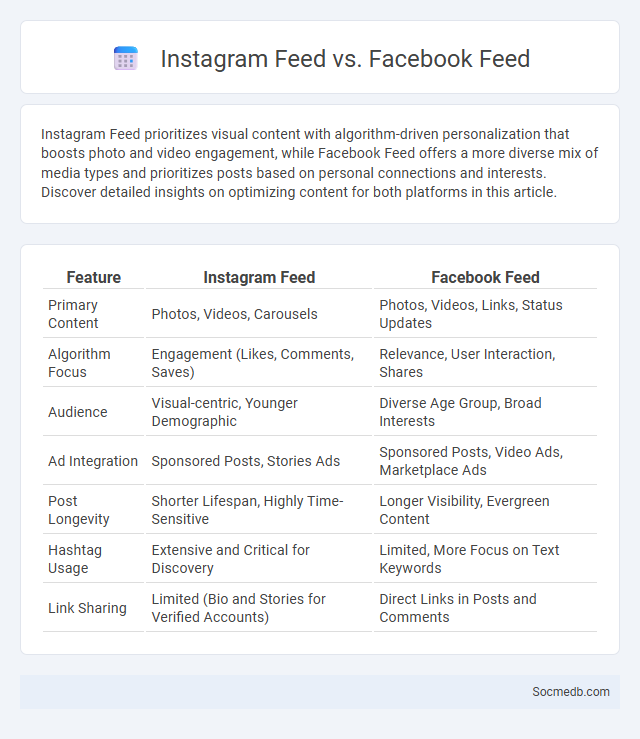
Photo illustration: Instagram Feed vs Facebook Feed
Instagram Feed prioritizes visual content with algorithm-driven personalization that boosts photo and video engagement, while Facebook Feed offers a more diverse mix of media types and prioritizes posts based on personal connections and interests. Discover detailed insights on optimizing content for both platforms in this article.
Table of Comparison
| Feature | Instagram Feed | Facebook Feed |
|---|---|---|
| Primary Content | Photos, Videos, Carousels | Photos, Videos, Links, Status Updates |
| Algorithm Focus | Engagement (Likes, Comments, Saves) | Relevance, User Interaction, Shares |
| Audience | Visual-centric, Younger Demographic | Diverse Age Group, Broad Interests |
| Ad Integration | Sponsored Posts, Stories Ads | Sponsored Posts, Video Ads, Marketplace Ads |
| Post Longevity | Shorter Lifespan, Highly Time-Sensitive | Longer Visibility, Evergreen Content |
| Hashtag Usage | Extensive and Critical for Discovery | Limited, More Focus on Text Keywords |
| Link Sharing | Limited (Bio and Stories for Verified Accounts) | Direct Links in Posts and Comments |
Overview of Social Media Feeds
Social media feeds aggregate real-time updates, combining diverse content types like text, images, videos, and advertisements from users, pages, and brands. Algorithms prioritize posts based on user behavior, engagement metrics, and relevance, ensuring a personalized experience. Popular platforms such as Facebook, Instagram, Twitter, and TikTok utilize distinct feed structures to maximize content visibility and user interaction.
What Is an Instagram Feed?
An Instagram feed is a visual collection of photos and videos displayed on a user's profile, showcasing their content in chronological or curated order. It serves as the primary way followers engage with a user's posts, reflecting their personal brand, interests, or business identity. The feed's design and consistency significantly impact user interaction and follower growth on the platform.
What Is a Facebook Feed?
A Facebook Feed is a continuously updating list of posts, photos, videos, and interactions from your friends, pages you follow, and groups you're a part of, designed to keep you informed and engaged. It uses an algorithm to prioritize content based on your interests, interactions, and activity patterns to deliver a personalized experience. Your Facebook Feed serves as the central hub for discovering new content, staying connected, and sharing updates within your social network.
General Concept of a Social Media Feed
A social media feed is a dynamic, continuously updating stream of content tailored to your interests, preferences, and interactions on platforms like Facebook, Instagram, and Twitter. It aggregates posts, images, videos, and advertisements, leveraging algorithms to prioritize relevance and engagement. Understanding how your feed operates helps enhance your online experience by surfacing meaningful and timely information.
Key Differences: Instagram Feed vs Facebook Feed
Instagram Feed emphasizes visually-driven content with high-resolution images and short videos, catering to users seeking aesthetic and engaging posts. Facebook Feed offers a broader mix of media types including text updates, links, videos, and shared articles, supporting more diverse interactions and longer-form engagement. User demographics also differ, with Instagram attracting younger audiences while Facebook maintains a more varied age range, impacting content style and platform use.
User Experience Across Feeds
Your social media experience is shaped by personalized feeds that prioritize engaging and relevant content based on your interactions and preferences. Advanced algorithms analyze behavior patterns to curate a seamless flow of posts, stories, and ads, enhancing satisfaction and time spent on each platform. Optimizing feed design balances content diversity with user interest, minimizing overload while maximizing engagement and retention.
Content Types and Visual Presentation
Content types on social media include videos, images, infographics, stories, and live streams, each serving unique purposes for engaging diverse audiences. Visual presentation relies on high-quality graphics, consistent color schemes, and compelling layouts to capture attention and convey messages effectively. Your social media success depends on strategically combining varied content types with visually appealing designs to boost interaction and brand recognition.
Algorithms and Content Prioritization
Social media platforms use sophisticated algorithms to analyze user behavior, preferences, and engagement patterns to prioritize content in feeds. These algorithms prioritize posts that generate higher interaction rates, such as likes, comments, and shares, to maximize user retention and ad revenue. Understanding how platforms like Facebook, Instagram, and TikTok rank content helps creators optimize their posts for greater visibility and audience reach.
Engagement Rates: Instagram vs Facebook
Instagram consistently achieves higher engagement rates compared to Facebook, with average rates around 1.22% per post versus Facebook's 0.08%. Visual content and Stories format on Instagram drive stronger user interactions such as likes, comments, and shares. Brands targeting younger demographics benefit more from Instagram's engagement metrics, while Facebook remains effective for broader audience reach.
Choosing the Right Feed for Your Brand
Selecting the right social media feed is crucial for aligning your brand's voice with audience expectations and engagement patterns. Analyze your target demographic's platform preferences, content consumption habits, and interaction rates to tailor feeds that amplify brand visibility and loyalty. Leveraging data-driven insights ensures streamlined content delivery, fostering organic growth and maximizing marketing ROI.
 socmedb.com
socmedb.com